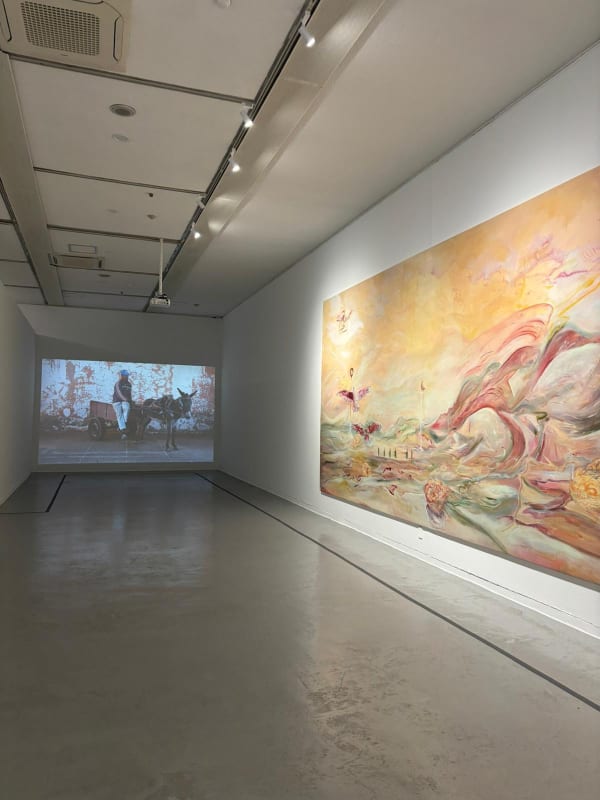The Africa Pavilion
Curators: Lassana Igo Diarra, Dayana Vafina
Partners: Tabari Art Space, Selebe Yoon
Dreamscape delves into the collective and individual dreams of the African continent, showcasing over artists from 16 countries: Algeria, Morocco, Mali, Nigeria, Mauritius, Ghana, Democratic Republic of Congo, South Africa, Sudan, Senegal, Kenya, Cameroon, Benin, Mauritania, Egypt and Mozambique. While our selection cannot substitute the multitude of voices from the continent, today the selected artists will leave the door to the Dreamscape ajar paving the way for wider representation in the future.
Dreamscape features a roster of over 20 artists from across Africa and the diaspora, each bringing their unique perspective and artistic style: Ala Kheir (Sudan), Amina Zoubir (Algeria-France), Amsatou Diallo (Mali), Andrew Tshabangu (South Africa), Bakary Emmanuel Daou (Mali), Baudouin Mouanda (Congo), Barthélémy Toguo (Cameroon), Guy Wouete (Cameroon), Hamedine Kane (Mauritania), Hashel Al Lamki (Kenya – UAE), Jihan El-Tahri (Egypt), James Barnor (Ghana), Khalil Nemmaoui (Morocco), Mamadou Konaté (Mali), Mario Macilau (Mozambique), Mbaye Diop (Senegal), Melinda Fourn (Benin), Naomi Lulendo (Congo-Guadeloupe), Nirveda Alleck (Mauritius), Uche Okpa-Iroha (Nigeria), Younes Baba-Ali (Morocco).
At the heart of the exhibition lie three questions: How has Africa been dreamt of? What does Africa dream of? What is a dream? To touch upon these questions a large selection of photographic artworks, video art, installations and paintings inhabited the Dreamscape. Through various media, the Dreamscape captures the tension between separation and unity, individuality and community. It explores broader themes such as post-consumerism and climate issues, explores the connection between objects and memories, reveals recontextualized representations of identities, discloses the interaction between body and space, and discovers hidden particularities of the ordinary. Hashel Al Lamki, the Emirati visual artist of Kenyan and Omani origins, presents his work Dreams and Moon, Reform and Belief (2023) that is a 6m x 3m expressionist oil-on-canvas painting inspired by the Hafit Mountain in Al Ain, blending elements of nature and contemporary symbols to explore the artist's journey of self-discovery and reconciliation with his diverse heritage. Naomi Lulendo’s images depict silhouettes of Congolese female fetishes in French collections, floating in a digital space, with a lenticular print that appears and disappears as visitors move, evoking the mystical power of these looted objects and questioning their existence in ultra-digitized spaces. Nirveda Alleck’s photographs challenge the conventional standards of beauty and identity by documenting the way dried clay assumes different hues on different skin tones.
The unique point of Dreamscape is its exploration of Africa’s dreams through the lens of both collective aspirations and personal narratives. The exhibition responds to the complexity of the African continent, emphasizing the ongoing search for unity amidst diversity. As Black feminist scholar Njoki Wane said, "An African renaissance can be achieved through unity by acknowledging our differences and capitalizing on our similarities."
This exhibition goes beyond mere artistic expression, addressing significant ideas around identity, belonging, and the future of the continent. Dreamscape envisions Africa as both a space of dreamlike possibility and a site of grounded realism, where aspirations collide with the challenges of modern life.
Dreamscape will be hosted at Gwangju Museum of Photography Hall. The venue offers an ideal setting for this expansive exhibition, providing ample room for large-scale installations as well as intimate artistic settings.

